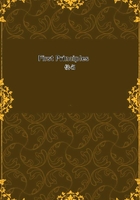
第93章
Little as we habitually observe it, it is yet certain that the impulses ouractions impress from moment to moment on surrounding objects, are propagatedthrough them in vibrations. It needs but to look through a telescope of highpower, placed on a table, to be convinced that each pulsation of the heartgives a jar to surrounding things. Motions of another order -- those namelyof the ethereal medium -- teach us the same thing. Every fresh discoveryconfirms the hypothesis that light consists of undulations, and that therays of heat have a like fundamental nature: their undulations differingfrom those of light only in their comparative lengths. Nor do the movementsof electricity fail to furnish us with illustrations; though of a differentorder. The northern aurora may often be observed to pulsate with waves ofgreater brightness; and the electric discharge through a vacuum shows byits stratified appearance that the current is not uniform, but comes in gushesof greater and lesser intensity. Should it be said that there are some motions,as those of projectiles, which are not rhythmical, the reply is that theexception is apparent only, and that these motions would be rhythmical ifthey were not interrupted. It is common to assert that the trajectory ofa cannon-ball is a parabola; and it is true that (omitting atmospheric resistance)the curve described differs so slightly from a parabola that it may practicallybe regarded as one. But, strictly speaking, it is a portion of an extremelyeccentric ellipse, having the Earth's centre of gravity for its remoter focus;and but for its arrest by the substance of the Earth, the cannon-ball wouldtravel round that focus and return to the point whence it started; againto repeat this slow rhythm. Indeed, while seeming to do the reverse, thedischarge of a cannon furnishes one of the best illustrations of the principleenunciated. The explosion produces violent undulations in the surroundingair. The whizz of the shot, as it flies towards its mark, is due to anotherseries of atmospheric undulations. And the eccentric movement round the Earth'scentre, which the cannon-ball is beginning to perform, being checked by solidmatter, is transformed into a rhythm of another order; namely, the vibrationwhich the blow sends through neighbouring bodies.*
Rhythm is very generally not simple but compound. There are usually atwork various forces, causing undulations differing in rapidity; and hencebesides the primary rhythms there arise secondary rhythms, produced by theperiodic coincidence and opposition of the primary ones. Double, triple,and even quadruple rhythms, are thus generated. One of the simplest instancesis afforded by what in acoustics are known as "beats": recurringintervals of sound and silence which are perceived when two notes of nearlythe same pitch are struck together and which are due to the alternate correspondenceand antagonism of the atmospheric waves. In like manner the phenomena dueto what is called interference of light, result from the periodic agreementand disagreement of ethereal undulations -- undulations which, by alternatelyintensifying and neutralizing each other, produce intervals of increasedand diminished light. On the sea-shore may be noted sundry instances of compoundrhythms. We have that of the tides, in which the daily rise and fall undergoesa fortnightly increase and decrease, due to the alternate coincidence andantagonism of the solar and lunar attractions. We have again that which isperpetually furnished by the surface of the sea: every large wave bearingsmaller ones on its side, and these still smaller ones, with the result thateach flake of foam, along with the portion of water bearing it, undergoesminor ascents and descents of several orders while it is being raised andlowered by the greater billows. A different and very interesting exampleof compound rhythm occurs in the little rills which, at low tide, run overthe sand out of the shingle banks above. Where the channel of one of theseis narrow and the stream runs strongly, the sand at the bottom is raisedinto a series of ridges corresponding to the ripple of the water. On watching,it will be seen that these ridges are being raised higher and the ripplegrowing stronger; until at length, the action becoming violent, the wholeseries of ridges is suddenly swept away, the stream runs smoothly, and theprocess commences afresh.
Rhythm results wherever there is a conflict of forces not in equilibrium.
If the antagonist forces at any point are balanced, there is rest; and inthe absence of motion there can of course be no rhythm. But if instead ofa balance there is an excess of force in one direction -- if, as necessarilyfollows, motion is set up in that direction; then for the motion to continueuniformly in that direction, the moving matter must, notwithstanding itsunceasing change of place, present unchanging relations to the sources offorce by which its motion is produced and opposed. This however is impossible.
Every further transfer through space, by altering the ratio between the forcesconcerned, must prevent uniformity of movement. And if the movement cannotbe uniform, then (save where it is destroyed, or rather transformed, as bythe collision of two bodies travelling through space in a straight line towardseach other) the only alternative is rhythm.